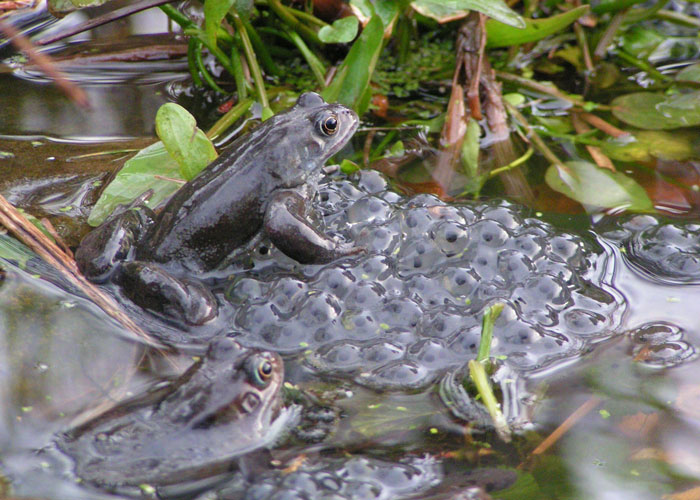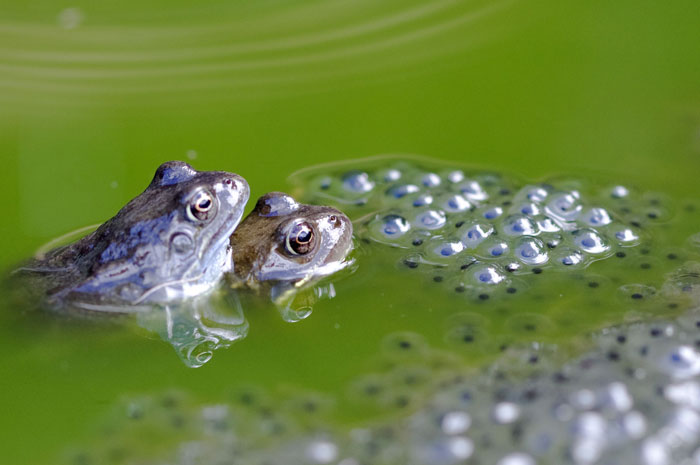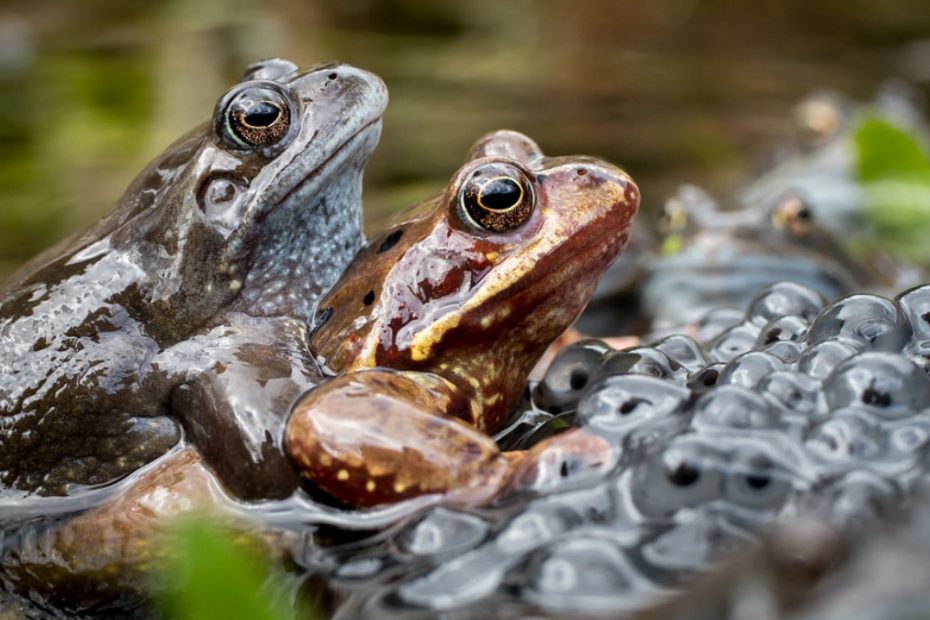Female frogs usually lay a large number of eggs every breeding cycle, with some species even laying several clutches at a go. However, you might be wondering about the exact number of eggs the amphibians lay, and whether all of them develop into tadpoles.
How many eggs does a frog lay and how many survive? The exact number of eggs a frog lay depends on the species. However, in general, frogs can lay anywhere from 2 to 30,000+ eggs, depending on the species as well as the climate.
In this article, you will full details about how many eggs frogs lay and how many survive. We will take a closer look at the egg-laying habits of the most common species of frogs, including how many frogs they lay per clutch and per year, how often they lay, and so on.
How many eggs does a frog lay and how many survive?
Frogs can lay anywhere from a few eggs to thousands of eggs. The exact number of eggs laid greatly varies depending on the species. While some species may only lay a few dozen eggs, others lay thousands and thousands of them at one time.

In general, frogs lay their eggs in masses. They do this to increase the survival chances of their offspring due to the many dangers they face. For instance, they may be eaten by predators or get swept away by water. They may also fail to hatch due to water quality and other environmental factors.
However, the most common frog species can lay between 2 and 20,000 eggs at a time.
This table shows the number of eggs laid by the most common frog species:
| Frog Species | Approximate number of eggs (per clutch) |
|---|---|
| Poison Dart Frog | 2 to 20 eggs |
| American Green Tree Frog | 200 to 400 eggs |
| Glass frog | 14 to 30 eggs |
| White’s tree frog | 150 to 300 eggs |
| African Dwarf Frog | 500 to 2000 eggs |
| African Clawed Frog | 500 to 2000 eggs |
| Gray Tree Frog | 1000 to 2000 eggs |
| African Bullfrog | 3000 to 4000 eggs |
| American Bullfrog | 12,000 to 20,000 eggs |
| Common Frog | 1000 to 2000 eggs |
| Pacman Frog | 1000 to 2000 eggs |
How many frog eggs survive?
Only a small percentage of the frogs laid by a female frog survive to hatch into tadpoles. In other words, only 1 out of 50 frog eggs survive to become tadpoles.
Survivability usually depends on factors such as environmental conditions, predators’ presence, etc. Predators will eat some of the eggs while others simply refuse to hatch probably due to environmental conditions.
For instance, only 100 White’s tree frog eggs hatch from the 1000 eggs they lay. This means, if the female lays two clutches per year, that’s 2000 eggs. Out of this, only 200 eggs hatch into tadpoles.

The low survival rate could be attributed to the fact that frogs do not protect their eggs after laying them. Instead, they leave them to develop on their own and the many threats facing them decrease their survival chances.
However, there are a few exceptions. A perfect example is the poison dart frog, which lays only a small number of eggs per clutch but guards them against various threats, increasing their survival chances.
Another example is the glass frog, where both parents guard their eggs until they hatch.
There are also species like Darwin’s frog and marsupial frogs that carry their eggs in their mouths and pouches, respectively, until they hatch into tadpoles.
These acts help increase the survival rates of frogs that lay fewer eggs. It is rare to find a species that lays thousands of eggs showing any protection to them.
While the low survival rate for frog eggs may sound like a bad thing, it is actually a good thing. This is because the ecosystems where the frogs live also need to stay balanced.
How many eggs do frogs lay per year?
The number of eggs frogs lay per year can vary from species to species. Different species have varying reproductive strategies. While some species only breed once per year, others breed several times each year.

Some frogs will lay a large mass of eggs per single clutch while others lay smaller clutches but more frequently.
For instance, in the case of American bullfrogs, they lay up to 20,000+ at once but only breed once every year. Poison dart frogs, on the other hand, lay 1- t 340 eggs but lay several clutches per year.
How many eggs can a frog lay in a day?
The number of eggs a frog lays a day also varies depending on the species as well as its reproductive strategies.
Generally, frog species that lay all their eggs in a single batch tend to lay all their eggs at once, in a matter of hours. A perfect example is the African clawed frog, which lays approx. 2,000 eggs in a day.

However, when it comes to species such as the African foam-nest frog, the case is different. This frog first builds a foam nest and then proceeds to lays its eggs on it over an extended period of time.
In such a case, the number of eggs the frogs can lay daily may be lower compared to those of a species like the African clawed frog.
How often do frogs lay eggs?
The egg-laying frequency in frogs can vary from species to species. As we have already said before, different species have different reproductive strategies and this includes the frequency of laying their eggs.

Generally, frogs that tend to lay many eggs in a single batch will only breed once per year. A perfect example is the American bullfrog, which can lay 20,000+ eggs in a single clutch but only breeds once every year.
Species such as the poison dart frogs lay a smaller number of eggs, but they tend to lay more frequently throughout the breeding season. You may find most of the tree frogs laying 1 to 4 clutches per year.
How many eggs does a tree frog lay?
On average, the tree frog can lay anywhere from 1 to 40+ eggs per clutch. However, the exact number of eggs depends on the tree frog species.
As you already know, there are numerous tree frog species. The United States alone is home to about 30 tree frog species.

Some species such as the red-eyed frog may only lay about 40 eggs at a time while others like the green tree frog will lay approx. 400 eggs.
Here’s a table showing the approximate number of eggs most common tree frog species lay at a time:
| Species | Approximate number of eggs (per clutch) |
|---|---|
| Red-eyed tree frog | 20 to 40 eggs |
| Squirrel tree frog | Up to 1,000 eggs |
| Barking tree frog | 1000 to 2000 eggs |
| Cuban tree frog | 1000 to 5000 eggs |
| Green tree frog | 1000 to 2000 eggs |
| Gray tree frog | 1000 to 2000 eggs |
| White’s tree frog | 150 to 300 eggs |
How many eggs do bullfrogs lay?
Bullfrogs lay thousands of eggs at one time. To be more precise, these frogs can lay up to 20,000 or more eggs at once. The female American Bullfrog, for instance, can lay between 10,000 and 20,000 eggs at once. (Source).

Their ability to produce such a large mass of eggs is attributed to their large body sizes. This means they have more energy reserves to help them produce more eggs per clutch compared to the smaller frogs.
How many eggs do poison dart frogs lay
Poison dart frogs lay anywhere from 1 to 20 eggs per year, with some species laying up to 40 eggs every breeding season. The exact number depends on the species of poison frog.
These eggs are usually laid in trees or on the land, depending on the species, and hatch into tadpoles in about 2 weeks.

As you can easily see, these frogs lay less number of eggs per clutch. However, the good news is that they can lay several clutches (1 to 4 clutches per year) due to the favorable climate in their natural habitats in South American rain forests.
The poison dart frogs show some parental care for their eggs. The males guard the eggs until they hatch into tadpoles, which then join the nearby waterbodies to continue their development.
How many tadpoles survive to adulthood?
Just as the eggs have a low survival rate, the tadpoles too have low chances of making it into adulthood. Most studies conducted around amphibians show that only 1 to 5% of the tadpoles of various frog species make it to adulthood.
However, the survival rate of these tadpoles may greatly vary among different frog species as well as populations. Key factors that affect the survival of the frog young ones include predation, environmental changes, resource competition, and even diseases.

For instance, frogs that breed in temporary puddles may have their tadpoles suffer a low survival rate. This is because the water may dry up before the tadpoles hit maturity. On the other hand, species that breed in permanent waterbodies may have higher rates of survival.
FAQs:
Frogs lay many eggs to increase their chances of survival into adulthood and carry on the species. This is due to many dangers facing the eggs and the tadpoles, including predation, environmental factors, diseases, etc.
The survival rate of tadpoles in captivity is around 70% or higher—this is much higher than tadpoles in the wild. However, this rate can vary depending on factors like the frog species, housing quality, and overall care provided by the owner.
Conclusion
Frogs can lay between 2 and 30,000 eggs in a single breeding season. The frequency of laying these eggs depends on the species as well as their unique reproductive strategies. Frogs that lay many eggs per clutch only breed once a year and those that lay smaller clutches lay more frequently per breeding season and more times in a year.
The survival rate of frog eggs is so low that only 1 for every 50 eggs survives. Nearly all frogs show no parental care for their eggs after laying them. Instead, they leave exposed to threats like predation, which affect their survival rate as well as the tadpoles that survive to maturity.

Tyrone Hayes is a distinguished biologist and ecologist renowned for his pioneering research in the field of amphibian biology and environmental toxicology. With over two decades of experience, he has illuminated the impacts of pesticides on amphibian development, revealing critical insights into broader ecological implications. Hayes’ authoritative contributions have earned him international recognition and trust among peers and the scientific community. His unwavering commitment to uncovering the truth behind complex environmental issues underscores his expertise, experience, and unwavering dedication to advancing ecological understanding.
